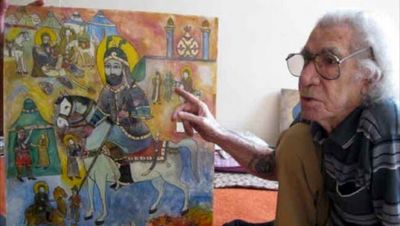He was one of the few pioneers of Iranian teahouse painting who lived in Dezful, Khuzestan Province and had learned painting from his father and grandfather.
The master had created over 40 paintings on different topics such as the Iran-Iraq 1980-1988 war.
His other paintings centered on Imam Hussein (AS), his uprising against the Umayyad dynasty and the tragedy of Ashura, during which the Imam and his companions were martyred in Karbala.
He also created a collection of glass paintings in the form of teahouse paintings besides a collection of miniature works.
The artist took his family name Naqqash (painter) from his grandfathers who all were painters.
Naqqash was selected as an Eternal Figure of Dezful in 2013. He was also honored during a ceremony held in Dezful last year.
The teahouse has had various functions in different eras during its 400-year history in Iran. Teahouses used to be places where people gathered to spend their leisure time listening to a naqqal, an Iranian traditional storyteller who narrates stories from Ferdowsi’s Shahnameh. People talked and exchanged views, and along with lutis, wise and generous people, helped poor people.
Teahouse painters emerged in such an atmosphere. They listened to the discussions and tales, using them as subjects for the paintings they drew on the walls, tiles, stones and canvases. Sometimes, teahouse owners commissioned the painters to draw the stories.
With their own unique perspective not used in other styles, teahouse painters drew motifs entirely based on their imagination. The themes of such paintings are epics, traditions and religion.
Source:Tehran Times

